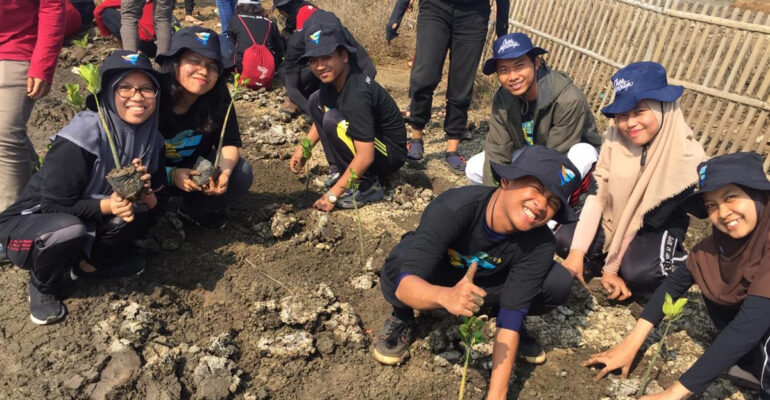IPB University Students Plant 7,500 Mangrove Seeds in Patra Manggala Village

Communities in Patra Manggala Village, Kemiri Subdistrict, Tangerang Regency, Banten used to think that the presence of mangroves disturbed tiger shrimp culture. Large scale mangrove tree felling had also been carried out in this area. In 2006, the harvest of tiger shrimp reached 20 kilograms per day. But after the absence of mangroves, shrimp yields gradually decreased. Even shrimp farming in this area was really dead.
Seeing this condition, students from the Water Resources Management Student Association, Faculty of Fisheries and Marine Sciences (Himasper FPIK), IPB University routinely plant mangroves annually in Patra Manggala Village. Mangrove seedlings are planted because mangroves are believed to be plants that can absorb carbon emissions and are an important area that supports aquatic biota to breed.
Mangrove planting in 2019 this time is titled Green Belt Conservation (GBC) 2019 and carried out by 100 students and village communities. The Tangerang Regency Fisheries Office also assisted in the process of planting 7,500 mangroves in Patra Manggala Village.
Rafialwan Athariq Subing as the Chairperson of Himasper of FPIK IPB University said that the coastal area of Patra Manggala Village was used by local people in forestry, agriculture and fisheries activities. The combination of these three disciplines is often called management by the sylvofishery system. Cultivation, planting, maintenance and preservation of forests are carried out simultaneously and continuously.
"The existence of mangroves on the coast is important. We provide direct assistance to the mangrove observers group in Patra Manggala Village to restore the water conditions as they should, "said Hari Mahardika, representative of the Tangerang Regency Fisheries Department.
Planting mangrove again is the right step. This is indicated by the recovery of shrimp farming activities. The yields that had died then increased to one ounce per day.
Mulyana, or who is familiarly called as Pak Taya, admitted that currently the cultivation can reach 5 kilograms per day after planting mangroves.
"People are starting to realize that mangroves are important. Support from all parties is highly expected to restore the condition of our coastal area. This activity is one of the supports obtained by the local community, "said Mulyana as the Coordinator of the Patra Manggala Mangrove Observation Group.
Meanwhile, Naufal Hawali Bastaman explained that in addition to planting 7,500 mangrove seeds obtained from local agencies concerned with mangrove conservation, discussions with the community were also held. The discussion was led by Pardi Pay, S.Pi from Forest Watch Indonesia (FWI), which accommodated the problems felt by the local Mangrove Observer Group.
The results of the discussion will be material that is reviewed by Himasper FPIK IPB University. The formulation of mangrove management advice on the coast of Patra Manggala Village will be carried out under the guidance of Dr. Ir. Fredinan Yulianda, M.Sc as the output given from the holding of this activity.
Great hopes were expressed by Dr. Majariana Krisanti as Chair of the Department of Water Resources Management (MSP), FPIK IPB University. Dr Majariana hopes that this activity does not stop here.
"The sustainability of mangrove planting activities is a task that must be done by Himasper FPIK IPB University. I also hope that the formulation of mangrove management recommendations for Patra Manggala Village can be resolved immediately and can be immediately submitted to the local Regional Government as a reference for policies that can be taken. (NR)



